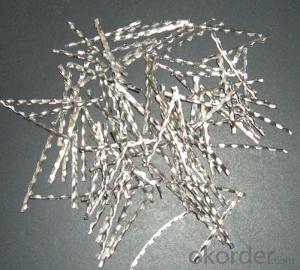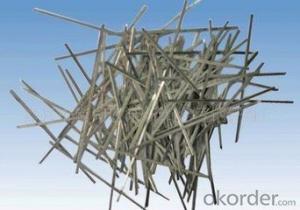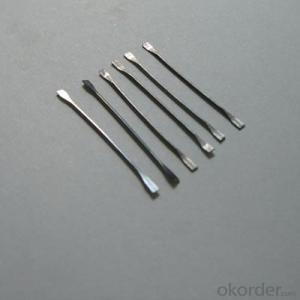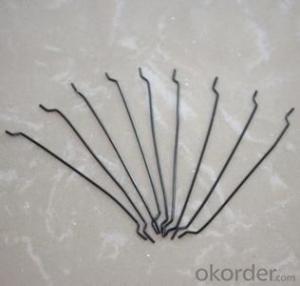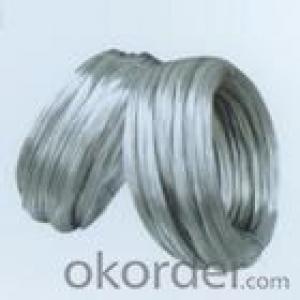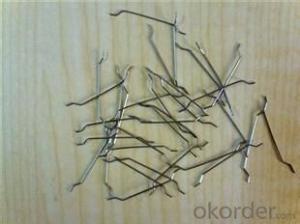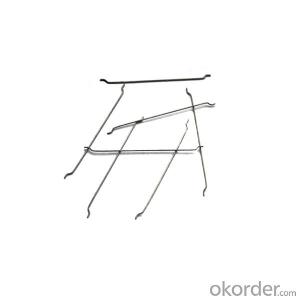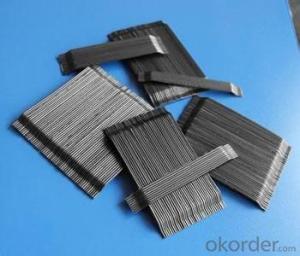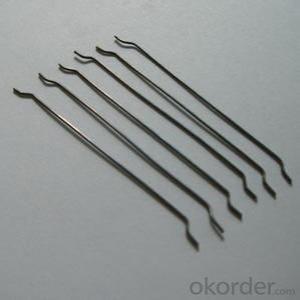Steel Fiber Loose High Tensile Strength For Concrete
- Loading Port:
- Tianjin
- Payment Terms:
- TT OR LC
- Min Order Qty:
- 1000 kg
- Supply Capability:
- 30000 kg/month
OKorder Service Pledge
OKorder Financial Service
You Might Also Like
Quick Details
Place of Origin: Jiangsu, China (Mainland)
Model Number: HT-MC
Material: Color Steel
certificated: ISO 9001
The Products
The milled steel fiber is made of high-strength steel wire through milling process, which makes the wire into wave shape to increase the touching area with concrete. By tightly binding with the mortar, the steel fiber can greatly enhance the performance of steel-fiber reinforced concrete, with strong cracking and shearing resistance, and tensile strength.
Specifications
1.material: steel plate
2.shape: waved
3.thickness: 0.5-13mm
4.length:35-5mm
5.tensile strength: >800Mpa
Specification | Thickness (mm) | Width (mm) | Length (mm) | Length- diameter l/d | Tensile strength (MPa) | Bending property |
T×W×L | 0.5-1.3 | 2-4 | 35-50 | 70~38 | ≥600 | ≥3 |
Picture
Steel fiber

any type
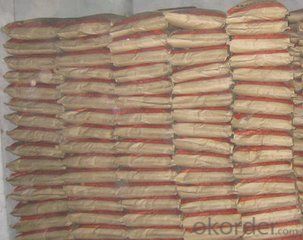
pp bag
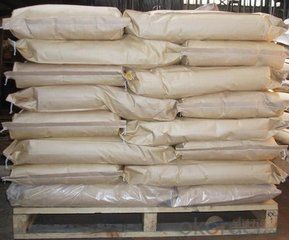
FAQ
See larger image
glued steel fibre in a row >1200Mpa
In using the steel fiber, proper mixing is one of the critical step, which will decide all physics and chemistry performance of the steel fiber reinforced concrete. Therefore, scientific mixing is needed to ensure the best performance of the steel fiber reinforced concrete, so that the index will reach and exceed the desired standard.
- Q:How does melt extract stainless steel fiber improve the resistance to spalling in concrete?
- Melt extract stainless steel fibers improve the resistance to spalling in concrete by enhancing the overall strength and durability of the material. These fibers act as reinforcement, preventing the propagation of cracks and reducing the risk of concrete spalling. Additionally, they enhance the bond between the concrete matrix and the fibers, resulting in increased resistance to spalling caused by thermal stresses, impact, or other external factors.
- Q:What is the effect of melt extract stainless steel fiber on the fatigue life of asphalt mixtures?
- The use of melt extract stainless steel fiber in asphalt mixtures has a positive effect on the fatigue life of the material. These fibers are added to asphalt mixtures to improve their mechanical properties and enhance their performance under repeated loading conditions. The addition of stainless steel fibers in asphalt mixtures helps to increase the resistance to fatigue cracking. Fatigue cracking is a common distress in asphalt pavements, especially in high-traffic areas, where repeated loading from vehicles can cause the material to weaken and eventually crack. By incorporating stainless steel fibers, the asphalt mixture becomes more resilient and can withstand higher levels of stress without developing cracks. The stainless steel fibers act as reinforcement within the asphalt matrix, providing additional strength and improving the cohesion of the material. This reinforcement helps to distribute the load more evenly across the pavement, reducing the concentration of stress in specific areas and minimizing the formation of fatigue cracks. Furthermore, the presence of stainless steel fibers in the asphalt mixture also improves its resistance to permanent deformation or rutting. Rutting occurs when the asphalt material deforms and becomes permanently displaced under the repeated traffic loads. The fibers help to stabilize the asphalt matrix, preventing excessive deformation and maintaining the integrity of the pavement structure. Overall, the addition of melt extract stainless steel fibers in asphalt mixtures significantly enhances the fatigue life of the material. It improves its resistance to fatigue cracking and rutting, leading to longer-lasting and more durable asphalt pavements. This can result in reduced maintenance and repair costs, as well as improved safety and comfort for road users.
- Q:What is the effect of melt extract stainless steel fiber on the impact resistance of concrete?
- The effect of melt extract stainless steel fiber on the impact resistance of concrete is that it significantly improves the concrete's ability to withstand impact forces. The inclusion of stainless steel fibers in the concrete matrix enhances its resistance to cracking and spalling, thereby increasing its overall durability and strength. These fibers act as reinforcement, distributing the impact load more evenly throughout the concrete structure, reducing the likelihood of sudden failure or damage. This ultimately leads to improved impact resistance and a longer service life for the concrete.
- Q:What is the effect of melt extract stainless steel fiber on the compressive strength of concrete?
- The use of melt extract stainless steel fiber in concrete can have a significant positive effect on its compressive strength. Stainless steel fibers are added to the concrete mixture to enhance its mechanical properties and improve its performance under compressive loading. The inclusion of stainless steel fibers in concrete helps to increase its tensile strength, ductility, and toughness. These fibers act as reinforcement within the concrete matrix, providing additional strength and preventing crack propagation. When subjected to compressive forces, the fibers distribute the stress more evenly throughout the concrete, reducing the concentration of stress points and improving its overall strength. The presence of melt extract stainless steel fibers in concrete can also enhance its resistance to temperature variations, shrinkage, and cracking. This is particularly beneficial in areas where the concrete is exposed to extreme weather conditions or subjected to thermal cycling. Additionally, the use of stainless steel fibers can improve the durability and longevity of concrete structures. The fibers help to inhibit the growth of cracks and prevent their propagation, resulting in a more durable and long-lasting concrete. However, it is important to note that the effect of melt extract stainless steel fibers on the compressive strength of concrete can vary depending on several factors, including the fiber content, aspect ratio, and distribution within the concrete matrix. It is crucial to carefully consider these factors and conduct proper testing to determine the optimal fiber dosage and distribution for achieving the desired compressive strength enhancement. In summary, melt extract stainless steel fibers have a positive effect on the compressive strength of concrete by enhancing its mechanical properties, improving its resistance to cracking, and increasing its durability.
- Q:What is the effect of melt extract stainless steel fiber on the modulus of elasticity of concrete?
- The inclusion of melt extract stainless steel fibers in concrete generally increases the modulus of elasticity. These fibers help in improving the tensile strength and stiffness of the concrete matrix, resulting in a higher modulus of elasticity.
- Q:How does the size and shape of melt extract stainless steel fiber affect its performance?
- The performance of melt extract stainless steel fiber is greatly influenced by its size and shape in different applications. Firstly, the fiber's surface area and volume are impacted by its size, which in turn affects its bonding strength with other materials. Smaller fibers generally have a larger surface area, allowing for stronger adhesion and better reinforcement of composite materials. Furthermore, the fiber's mechanical properties, such as tensile strength and ductility, are also influenced by its size. Smaller fibers tend to have higher tensile strength and increased flexibility, making them suitable for applications requiring improved structural integrity and resistance to deformation. Additionally, the performance of melt extract stainless steel fiber is dependent on its shape. Fibers with irregular or jagged shapes exhibit enhanced interlocking capabilities, enabling them to provide better mechanical anchorage within the matrix material. This improved interlocking mechanism enhances the fiber's ability to distribute stress and resist crack propagation, thereby increasing the overall durability and toughness of the composite material. On the other hand, fibers with a more regular or smooth shape offer advantages in terms of flowability and dispersibility during the manufacturing process. These fibers tend to exhibit better homogeneity and uniform distribution within the matrix material, resulting in improved mechanical properties and overall performance. In conclusion, the performance of melt extract stainless steel fibers is significantly influenced by their size and shape. Manufacturers can optimize the fiber's bonding strength, mechanical properties, and overall effectiveness in various applications, such as reinforcement in concrete, thermal insulation, or electrical conductivity, by carefully selecting the appropriate size and shape.
- Q:Can melt extract stainless steel fiber be used in precast concrete cladding panels?
- Yes, melt extract stainless steel fiber can be used in precast concrete cladding panels. The fibers enhance the strength, durability, and crack resistance of the concrete, improving the overall performance of the cladding panels.
- Q:Can melt extract stainless steel fiber be used in the construction of airport runways?
- Yes, melt extract stainless steel fiber can be used in the construction of airport runways. Stainless steel fibers are commonly used in concrete reinforcement due to their high tensile strength, corrosion resistance, and durability. In the case of airport runways, where heavy loads and frequent aircraft traffic are expected, the addition of stainless steel fibers can enhance the strength and performance of the concrete pavement. The use of melt extract stainless steel fiber in airport runway construction offers several benefits. Firstly, these fibers help to control cracking in concrete, which is crucial for maintaining the integrity and longevity of the runway. By effectively distributing stress throughout the concrete, stainless steel fibers prevent the formation and propagation of cracks, minimizing the potential for spalling, erosion, and other forms of deterioration. Moreover, stainless steel fibers can improve the impact resistance and load-carrying capacity of airport runways. The fibers act as reinforcement, effectively increasing the tensile strength and flexural toughness of the concrete. This reinforcement is particularly important in areas with heavy aircraft traffic, where the runway is subjected to continuous stress and dynamic loads from landing and takeoff operations. Additionally, melt extract stainless steel fibers are highly resistant to corrosion, ensuring the long-term durability of the runway. Stainless steel is known for its ability to withstand harsh environmental conditions, including exposure to deicing salts and chemicals commonly used at airports. This corrosion resistance helps to maintain the structural integrity of the concrete pavement and reduces the need for costly repairs or replacements. In summary, melt extract stainless steel fiber can be successfully utilized in the construction of airport runways. Its ability to control cracking, enhance load-bearing capacity, and resist corrosion makes it an excellent choice for reinforcing the concrete pavement in areas that require high durability and strength, such as airport runways.
- Q:Are there any specific mixing requirements for concrete with melt extract stainless steel fiber?
- Yes, there are specific mixing requirements for concrete with melt extract stainless steel fiber. The fibers should be added during the mixing process and evenly dispersed throughout the concrete to ensure proper reinforcement. Additionally, the mixing time may need to be extended to ensure the fibers are uniformly distributed. It is important to follow the manufacturer's guidelines and recommendations for the specific type of stainless steel fiber being used to achieve the desired results.
- Q:How does melt extract stainless steel fiber improve the resistance of concrete to impact loads?
- Melt extract stainless steel fiber improves the resistance of concrete to impact loads in several ways. Firstly, the addition of stainless steel fibers to concrete significantly enhances its tensile strength and ductility. These fibers act as a reinforcement, distributing the applied load more evenly throughout the concrete matrix and reducing the concentration of stress points. This helps to prevent the formation and propagation of cracks, increasing the overall resistance of the concrete to impact loads. Moreover, the unique properties of stainless steel, such as high strength, corrosion resistance, and durability, contribute to the improved impact resistance of concrete. Stainless steel fibers are extremely tough and can withstand high impact forces without breaking or deforming. This toughness allows them to effectively absorb and dissipate energy during impact, preventing the occurrence of catastrophic failure. Additionally, the small size and high aspect ratio of melt extract stainless steel fibers promote better bonding between the fibers and the concrete matrix. This strong bond ensures that the fibers remain well-anchored within the concrete, even under high impact loads. This, in turn, increases the overall strength and integrity of the concrete, making it more resistant to impact-induced damage. Furthermore, the addition of stainless steel fibers can also enhance the post-cracking behavior of concrete. When cracks do occur due to impact loads, the fibers help to hold the cracked sections together, preventing further separation and limiting the extent of damage. This post-cracking behavior contributes to the overall improvement in the resistance of concrete to impact loads. In summary, melt extract stainless steel fiber improves the resistance of concrete to impact loads by enhancing its tensile strength, ductility, and toughness. The fibers contribute to a more even distribution of applied loads and prevent the formation and propagation of cracks. Their strong bond with the concrete matrix and ability to absorb and dissipate energy during impact further enhance the impact resistance of the concrete.
1. Manufacturer Overview |
|
|---|---|
| Location | |
| Year Established | |
| Annual Output Value | |
| Main Markets | |
| Company Certifications | |
2. Manufacturer Certificates |
|
|---|---|
| a) Certification Name | |
| Range | |
| Reference | |
| Validity Period | |
3. Manufacturer Capability |
|
|---|---|
| a)Trade Capacity | |
| Nearest Port | |
| Export Percentage | |
| No.of Employees in Trade Department | |
| Language Spoken: | |
| b)Factory Information | |
| Factory Size: | |
| No. of Production Lines | |
| Contract Manufacturing | |
| Product Price Range | |
Send your message to us
Steel Fiber Loose High Tensile Strength For Concrete
- Loading Port:
- Tianjin
- Payment Terms:
- TT OR LC
- Min Order Qty:
- 1000 kg
- Supply Capability:
- 30000 kg/month
OKorder Service Pledge
OKorder Financial Service
Similar products
New products
Hot products
Related keywords







